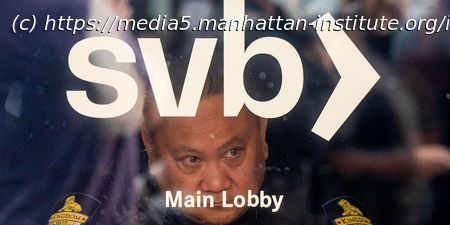It’s easy to blame an out-of-control-tech sector for recent financial failures, but Washington created the monster.
, when FTX founder Sam Bankman-Fried lost control of the massive cryptocurrency Ponzi scheme he had allegedly created, he ran home to mom and dad. A federal judge granted him bail on the multiple criminal charges he faces after his professor parents promised to keep an eye on their mischievous boy in their Palo Alto house. Now, all of move-fast-and-break-things Silicon Valley is running home to mom and dad because the Valley actually broke something that it needed. The only thing keeping hundreds of start-ups, as well as some more established tech firms, afloat right now is the fact that the federal government has bailed out all large depositors in the West Coast tech industry’s favored financial institution, Silicon Valley Bank (SVB). This state of affairs seems ironic, but it’s not. The trillions in easy money the federal government has pumped into the economy since the 2008 financial crisis in turn created the undisciplined tech sector.
The collapse of Silicon Valley Bank last Friday isn’t particularly interesting. A financial institution created 40 years ago to serve the emerging California tech world, SVB failed for the same reason that failed banks typically fail: it borrowed short-term, taking in money from depositors, and lent long-term. This strategy works—all banks do it—but SVB took it too far, too fast, with zero room for error. The bank’s deposits had tripled in just four years, the Financial Times reported, to nearly $200 billion. The bank took advantage of its status as being just under the threshold for heightened federal regulation to take enormous risk. It invested its short-term deposits—that is, money that customers could withdraw at any time from their checking and savings accounts—in long-term Treasury bonds, at a time when doing so was dangerous. The Federal Reserve has been raising interest rates, meaning that the value of older Treasury bonds issued at lower interest rates—the bonds that SVB held—was falling.
That might have been okay, except that SVB’s customers withdrew their money just as the value of SVB’s Treasury bonds was falling. Depositors asked for their money back partly because, as start-up investment has dried up in recent months, due partly to the rising interest rates, the tech firms face their own funding squeeze. These withdrawals forced SVB to sell its Treasury investments at a significant loss. That, too, could have been okay (sort of): banks around the country are nursing $600 billion in such losses.
Except: unlike at most banks, most of SVB’s depositors had more than $250,000 held at the bank. That’s above the FDIC’s normal insurance guarantee in case of bank failure. As word traveled through Silicon Valley that SVB was in distress, these large depositors began to yank their money—so quickly that, last Friday, regulators seized the bank. On Sunday night, regulators seized another medium-large bank, Signature, with a similar profile: large uninsured deposits, a tech-heavy customer base. In an effort to prevent runs on other mid-size banks, the FDIC said Sunday night that it would retroactively protect all depositors at the two failed banks, not just smaller, insured, depositors. The Federal Reserve and the Treasury Department also said that banks facing similar situations—having to sell Treasury securities to meet deposits—could instead borrow from the Fed (or “meet the needs of all their depositors,” in the Fed’s pleasant phrase) using the Treasury securities as collateral.






